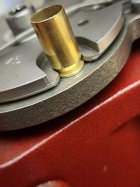But no serious shooter sizes in the same operation as seating. Right? Because if you do, you can't do any brass prep, like trim, chamfer, debur, or dry lube necks. Even most serious Dillon users size as a seperate operation, true?The tilt occurs when there is pressure created by the sizing die. When there is more push on one side of the plate it cause it to tilt. The amount of tilt varies dependign on how much pressure is required to size a case. Soft brass like Federal won't cause as much tilt as harder brass like Lapua.
It's just a faulty design Unfortunately.
For most pistol, and non-match 556 etc, it's probably fine, assuming there is any tilt.
And as another suggested, any tilt would be neutralized if a die opposite the sizer also touches the plate. A seater die or crimp die or hollow decapping die, for example, would stop tilt cold. Yes? Assuming there actually is tilt.
Can anyone SHOW this tilt? Or is it theoretical? Any videos?
Last edited:











